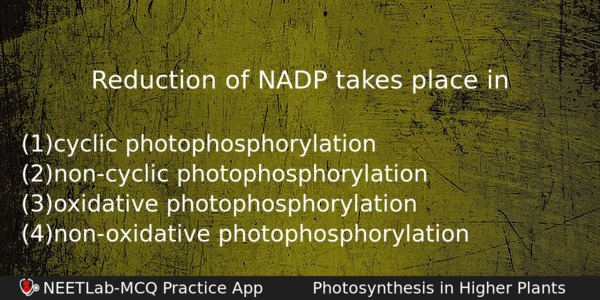| ⇦ | 
| ⇨ |
Reduction of NADP takes place in
Options
(a) cyclic photophosphorylation
(b) non-cyclic photophosphorylation
(c) oxidative photophosphorylation
(d) non-oxidative photophosphorylation
Correct Answer:
non-cyclic photophosphorylation
Explanation:
Phosphorylation takes place in two ways-cyclic and noncyclic. In noncyclic photophosphorylation high energy electrons released from P-680 (PSI) do not return to P-680 but pass through-pheophytin, plastoquinone, cytochrome b₆-f complex, plastocyan in and then enter P₇₀₀ and the excited electrons are used in the reducton of NADP to NADPH₂. When the electron from P₇₀₀ is carried by FeS (iron suphur protein complex), Fd (ferredoxin), is reduced and with the help of Fd-NADP reductase, NADP is reduced to NADP.
Related Questions: - All living organisms are linked to one another because
- Which one of the following pairs of animals comprises jawless fishes?
- Identify the site where Wuchereria bancrofti is normally found on human body
- Seed coat is not thin, mebranous in:
- Which of these are necessary for initiation of blood clotting process?
Topics: Photosynthesis in Higher Plants
(153)
Subject: Biology
(4253)
Important MCQs Based on Medical Entrance Examinations To Improve Your NEET Score
- All living organisms are linked to one another because
- Which one of the following pairs of animals comprises jawless fishes?
- Identify the site where Wuchereria bancrofti is normally found on human body
- Seed coat is not thin, mebranous in:
- Which of these are necessary for initiation of blood clotting process?
Topics: Photosynthesis in Higher Plants (153)
Subject: Biology (4253)
Important MCQs Based on Medical Entrance Examinations To Improve Your NEET Score
18000+ students are using NEETLab to improve their score. What about you?
Solve Previous Year MCQs, Mock Tests, Topicwise Practice Tests, Identify Weak Topics, Formula Flash cards and much more is available in NEETLab Android App to improve your NEET score.
Share this page with your friends

Leave a Reply